Tonjiru (or butajiru) is a savory pork and vegetable miso soup that you can easily make at home. Packed with B vitamins, fiber, and minerals, this healthy Japanese dish is nourishing and comforting. You’ll love it on a cold weather day!
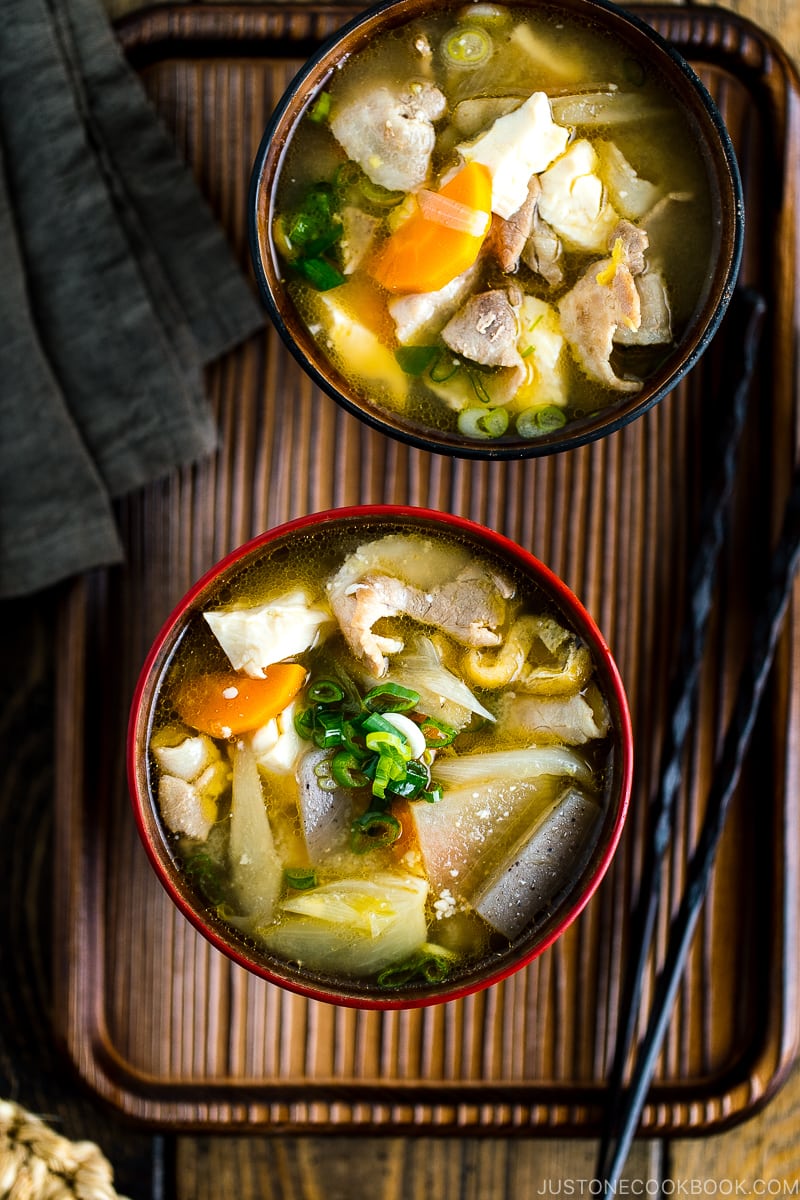
If you ask me what my favorite miso soup is, I would immediately say Tonjiru (豚汁). This pork and vegetable miso soup is one of the true comfort foods that I crave when I travel. There’s nothing more soothing than a simple meal of Onigiri rice balls and tonjiru.
You might have seen tonjiru featured on the popular Japanese TV drama called Shinya Shokudo (深夜食堂) or Midnight Diner: Tokyo Stories on Netflix. In the opening scene, the main character, Master, is seen making a big pot of this hearty soup with steam wafting through the kitchen.

If you find yourself extra hungry after watching all the scrumptious meals prepared by Master, it’s time to create them right in your own kitchen! Each of the dishes is doable and I have the recipes just for you (Season 1 recipes; Season 2 recipes). Let’s start with Tonjiru!
Table of Contents
What is Tonjiru?
Tonjiru (豚汁), literally meaning pork (ton) + soup (jiru), is basically a type of miso soup featuring pork and root vegetables. Some people call it butajiru (豚汁), too; it’s just another way to read the same kanji character. It’s a very popular dish in Japanese home cooking.
It’s a cold-weather staple that I enjoy year round. Not only is it delicious, it packs a lot of protein, minerals, fiber, and B vitamins that are great for both body and soul. It’s the kind of comfort food that will warm and restore you. So, what’s not to love?
Ingredients You’ll Need
This soup is loaded with hearty root vegetables and pork. Pork belly is the most common cut we use. It’s the same cut as bacon, but pork belly is uncured. You can find it thinly sliced at Japanese or Korean grocery stores or slice the meat thinly at home. Some grocery stores like Whole Foods may also offer pork belly at the butcher counter if you ask.
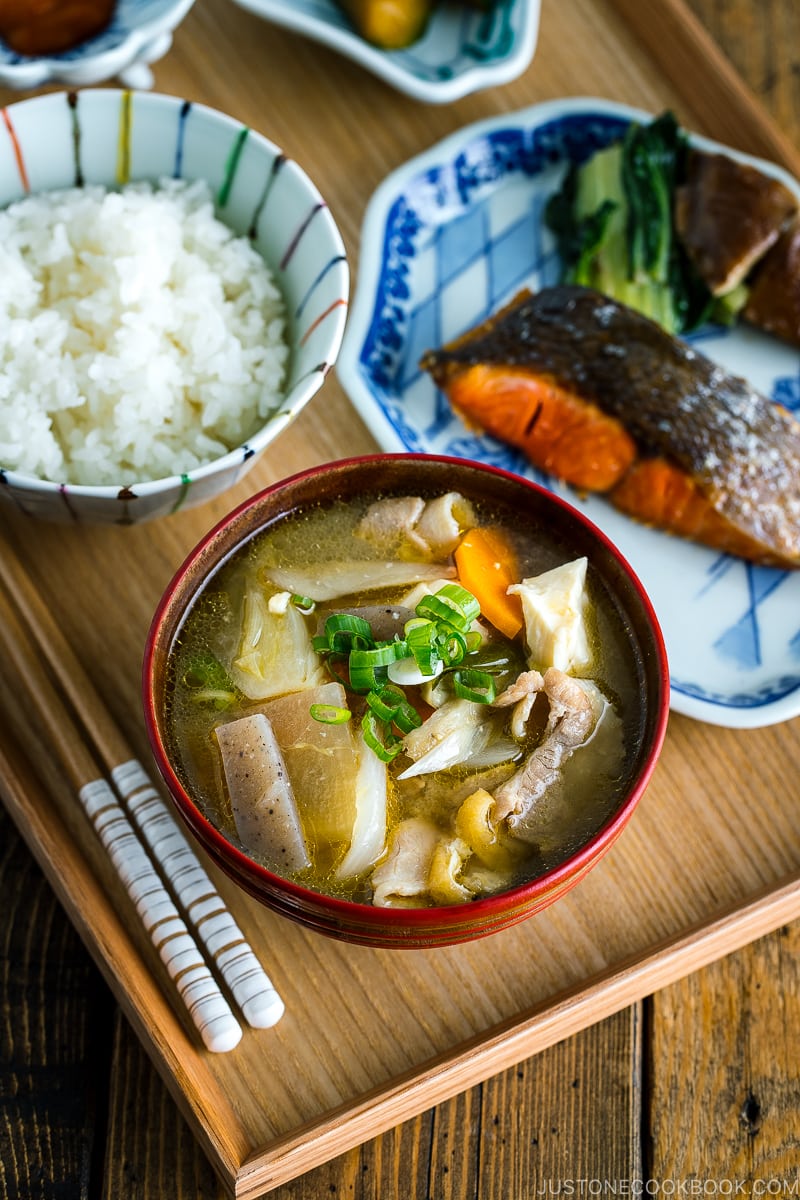
For the Meat, Vegetables, and Tofu
- sliced pork belly – sometimes, I use a combination of pork belly and less-fatty pork loin; for vegetarian/vegan, skip the meat and add more tofu, mushrooms, or veggies
- gobo (burdock root)
- Japanese taro (satoimo)
- onion
- daikon radish
- carrot
- konnyaku (konjac)
- kosher salt – I use Diamond Crystal brand; for cleaning the konnyaku
- Tokyo negi (naga negi; long green onion)
- aburaage (deep-fried tofu pouch)
- medium-firm tofu (momen dofu) – or use silken tofu; learn more at my tofu page.
For the Soup Broth
The sautéed pork belly gives the soup a sweet-savory flavor so some people use only water and leave out dashi in their tonjiru. However, I personally prefer dashi in the soup broth for more umami and depth.
- toasted sesame oil
- dashi (Japanese soup stock) – use standard Awase Dashi, dashi packet or powder, or Vegan Dashi
- miso (Japanese fermented soybean paste – each miso brand/type tastes different, so adjust the amount to taste
- ginger (grated, with juice)
For the Garnish
- green onion/scallion
- shichimi togarashi (Japanese seven spice) – optional, for a spicy kick
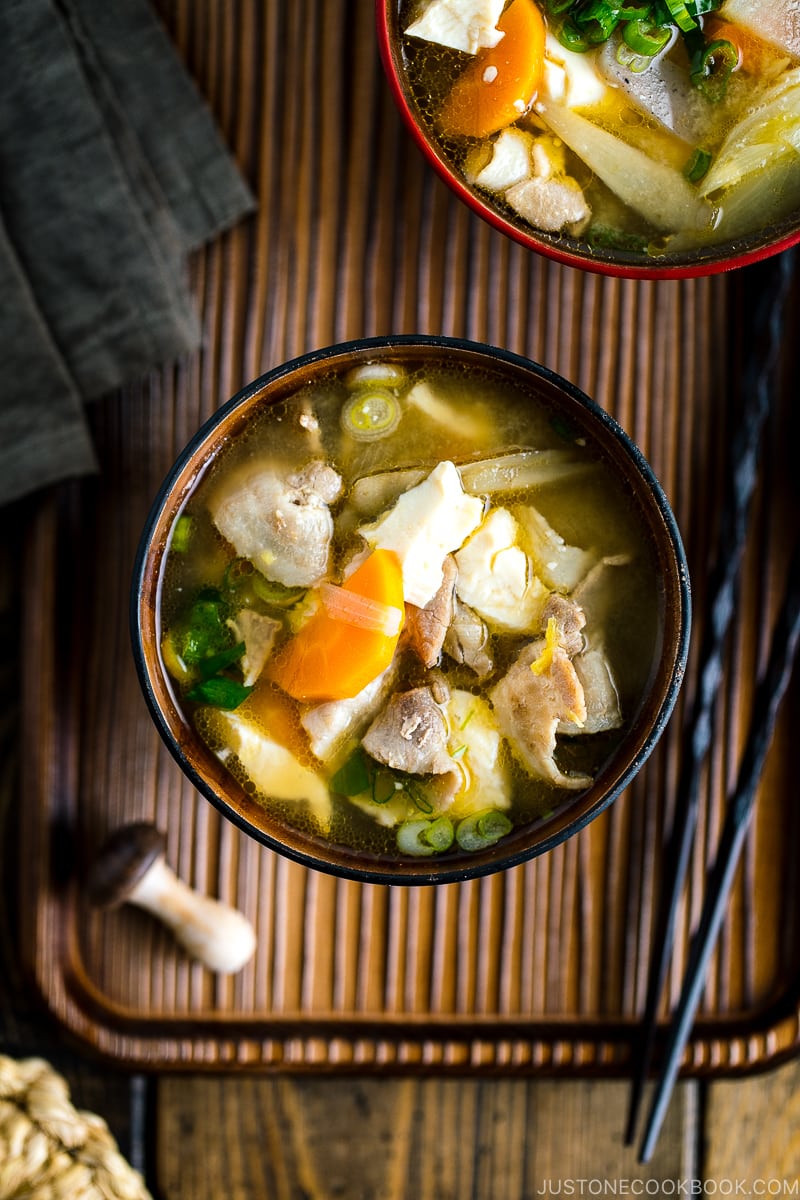
Variations and Substitutions
Make it vegetarian/vegan. As I mentioned above, you can skip the meat and add more tofu, mushrooms, or veggies.
Try different vegetables. Each household makes slightly different tonjiru with various ingredients and miso of their choice. Besides what I use in my recipe, I’ve seen:
- bean sprouts
- green cabbage or napa cabbage (hakusai)
- Asian garlic chives (nira)
- potato
- shimeji mushrooms (beech mushrooms)
- shiitake mushrooms
Use a different type of miso. There is no specific variety of miso that you must use here. If you like a certain type of miso paste (such as white, red, or awase miso), you can use it. If you are new to miso, read my miso pantry page to learn more.
How to Make Tonjiru
Following is a brief overview of the steps; see the full instructions in the recipe card below.
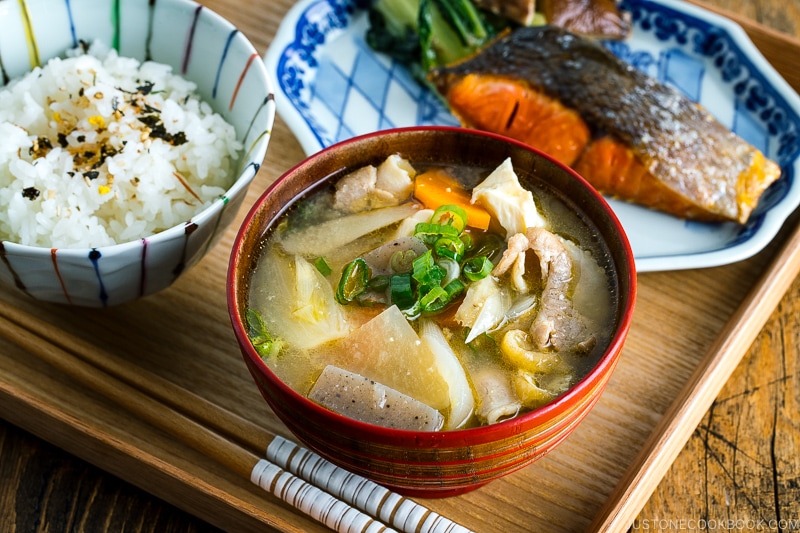
- Prepare and cut the ingredients into bite-sized pieces.
- Stir-fry the pork belly, vegetables, konnyaku, and aburaage in sesame oil in a large pot.
- Add the dashi stock to cover the ingredients. Simmer with the lid on until the vegetables are tender and a skewer inserted into a tough and thick vegetable pierces through. Turn off the heat.
- Add the miso, dissolving it completely.
- Add the grated ginger.
- Tear the tofu and add the pieces to the soup. Reheat on medium-low heat until it reaches a bare simmer (do not boil).
- Serve it in soup bowls and garnish with green onion.
Tips for Making Tonjiru
- Use at least 3 root vegetables – I highly recommend using gobo, daikon, and carrot. These three vegetables add unique flavor, depth, and sweetness.
- Cut the vegetables a similar size and shape – If you want a chunkier texture, you can cut them bigger, but make sure all the ingredients are similar in shape and size so they cook at the same rate.
- Stir-fry the meat and vegetables before adding soup stock – This brings out the flavor of the ingredients and adds depth.
- Let the flavor soak in while cooling – Make this soup ahead of time, if you can. While you let the soup cool and wait for the meal, the flavor will improve.
- Add miso right before serving – Miso is the most fragrant and tasty when it’s added right before serving. And do not let the miso soup boil as it loses its wonderful flavor.
Pressure Cooker (Instant Pot) Tonjiru
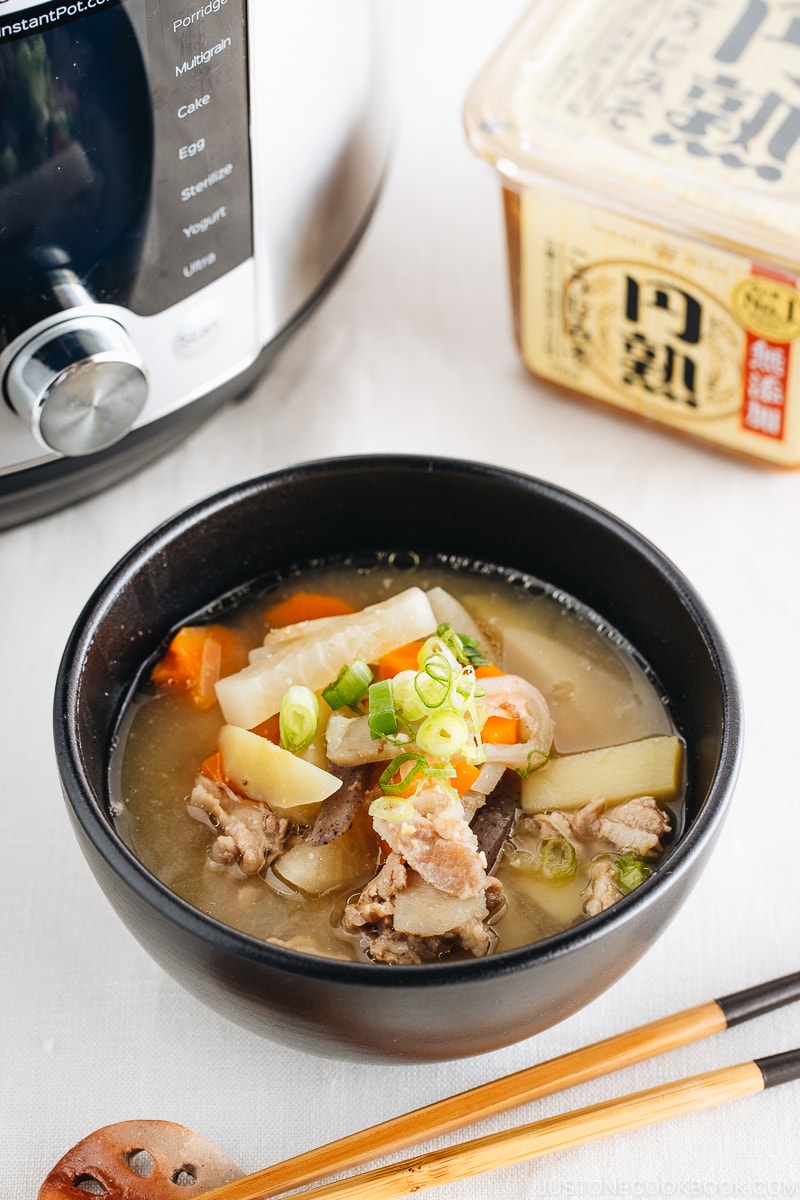
No time to keep a close watch on the pot? Try making this delicious soup in your pressure cooker using my convenient Instant Pot Tonjiru recipe.
What to Serve with Tonjiru
Nourishing and easily customizable, tonjiru is unquestionably home cooking of the best kind. You can make a big pot and enjoy it for the next 5 days!
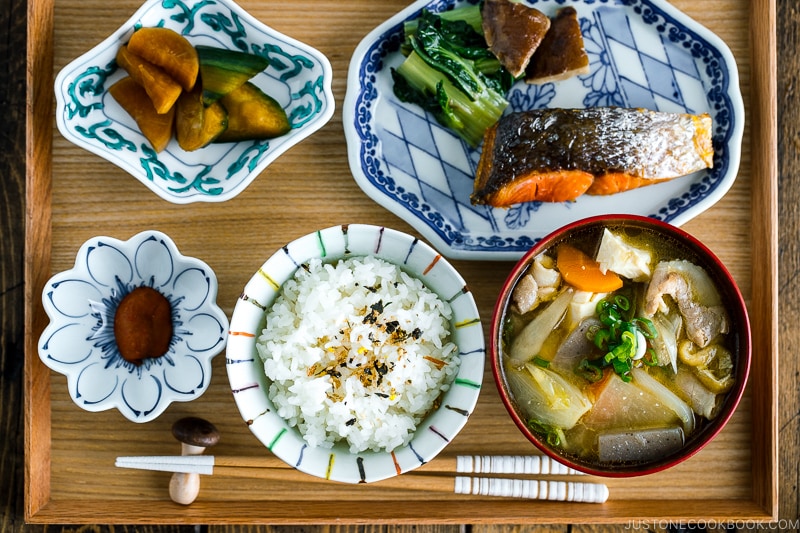
For a simple cozy dinner, I like to serve the soup to accompany the main dish like Japanese Salted Salmon along with steamed rice, pickles, and a few side dishes.
Wish to learn more about Japanese cooking? Sign up for our free newsletter to receive cooking tips & recipe updates! And stay in touch with me on Facebook, Pinterest, YouTube, and Instagram.
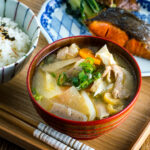
Tonjiru (Pork and Vegetable Miso Soup)
Video
Ingredients
For the Ingredients
- 9.6 oz sliced pork belly (at least 8 oz, 227 g of pork belly; I sometimes use a combination of pork belly and less-fatty pork loin; for vegetarian/vegan, skip the meat and add more tofu, mushrooms, or veggies)
- 3.5 oz gobo (burdock root) (½ length)
- 8 oz taro (satoimo) (3 pieces)
- 1 onion (6 oz, 170 g)
- 8.7 oz daikon radish (2 inches, 5 cm)
- 4.3 oz carrot (4 inches, 10 cm)
- ½ block konnyaku (konjac) (4.5 oz, 128 g)
- ¼ tsp Diamond Crystal kosher salt (for cleaning the konnyaku)
- 1 Tokyo negi (naga negi; long green onion)
- 1 piece aburaage (deep-fried tofu pouch)
- 1 tsp ginger (grated, with juice)
For the Soup
- 1 Tbsp toasted sesame oil
- 6 cups dashi (Japanese soup stock) (use standard Awase Dashi, dashi packet or powder, or Vegan Dashi)
- 6 Tbsp miso (each miso brand/type tastes different, so adjust the amount to taste)
- 7 oz medium-firm tofu (momen dofu) (½ package; or use silken tofu)
For the Garnish
- 1 green onion/scallion
- shichimi togarashi (Japanese seven spice) (optional, for a spicy kick)
Instructions
- It‘s easier to cut the pork belly if it‘s slightly frozen, so put it in the freezer for 15 minutes before you cut it. Meanwhile, gather all the ingredients.
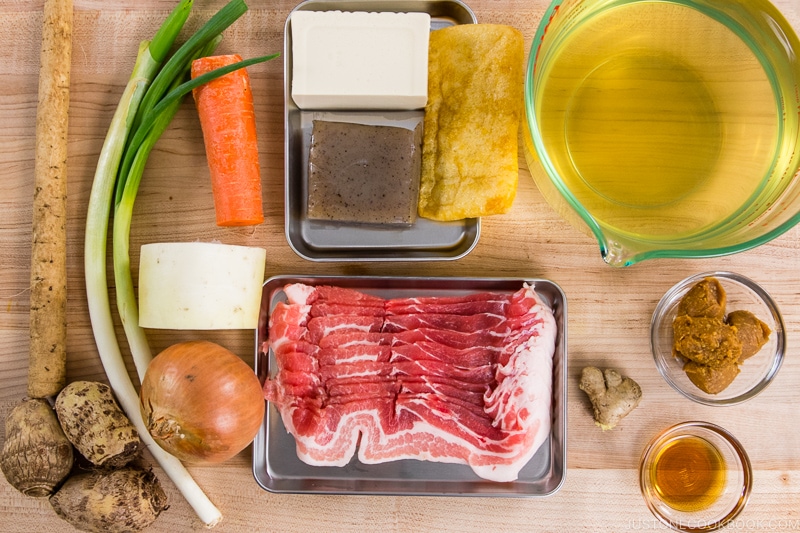
To Prepare the Ingredients
- Take out 9.6 oz sliced pork belly from the freezer and cut it into 1-inch (2.5-cm) pieces.
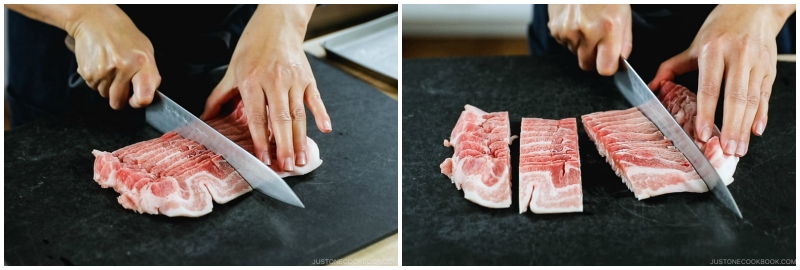
- Scrape the skin from 3.5 oz gobo (burdock root) with the back of your knife. The flavor of the gobo is right underneath the skin; therefore, you only need to scrape off the outer skin. Do not use a peeler.
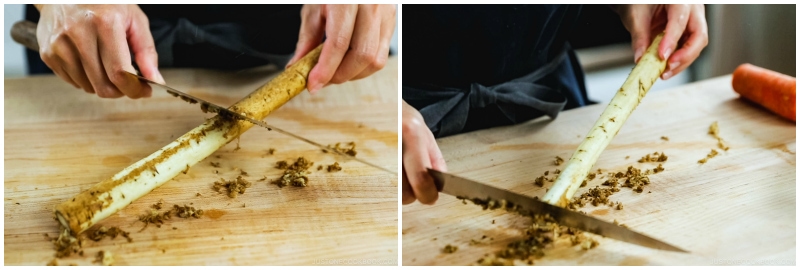
- Make a cross incision on the end of the gobo about 1 inch (2.5 cm) deep. This helps make shaving the gobo easier. Rotate the root as you shave the end of the gobo, like how you would sharpen a pencil with a knife. Soak the shaved gobo in water to prevent discoloration.
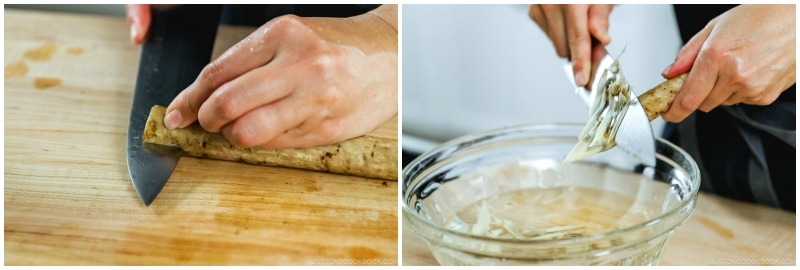
- Discard the dirty water and rinse the gobo under running water.
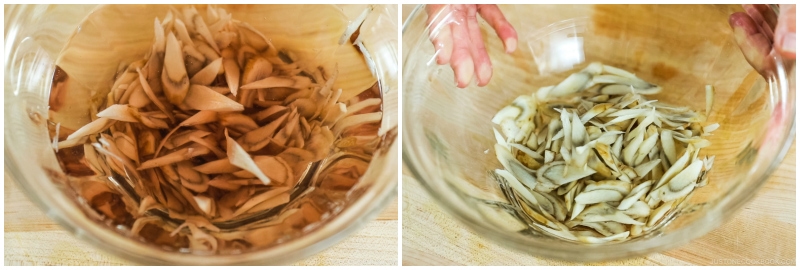
- Cut off both ends of 8 oz taro (satoimo) and peel the sides with the knife (or peeler).
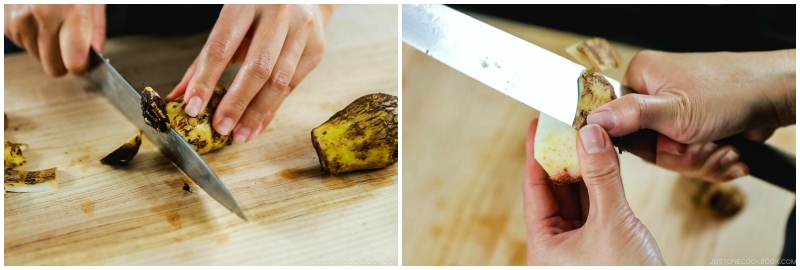
- Cut the taro into ⅓-inch (8 mm) slices and soak them in water to remove the sliminess.
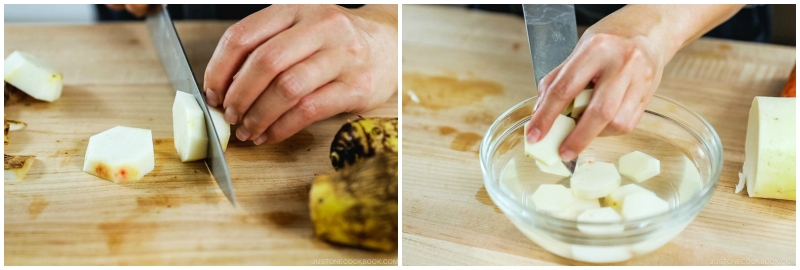
- Cut 1 onion in half lengthwise and cut it into thin slices.
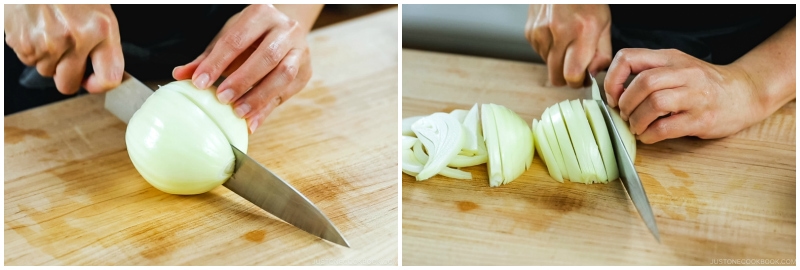
- Peel 8.7 oz daikon radish and cut it in half lengthwise.
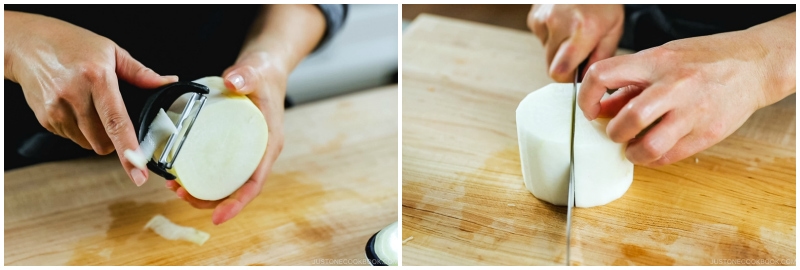
- Cut the daikon halves in half lengthwise again (now they are quartered) and cut into ⅛-inch (3-mm) slices. If your daikon is skinny, cut it into thin half-moon-shaped slices.
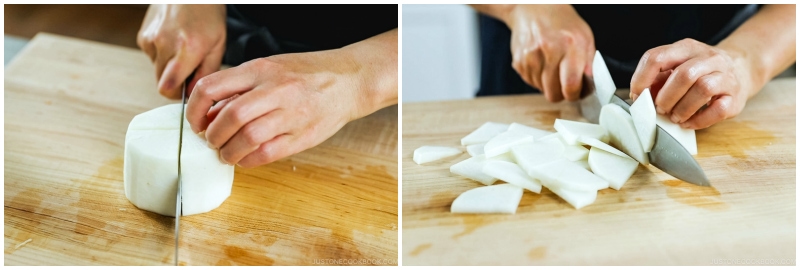
- Peel and cut 4.3 oz carrot in half lengthwise, and then slice thinly.
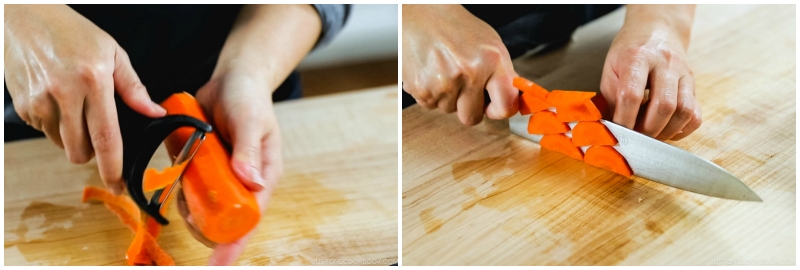
- Cut ½ block konnyaku (konjac) into small and thin rectangular pieces.
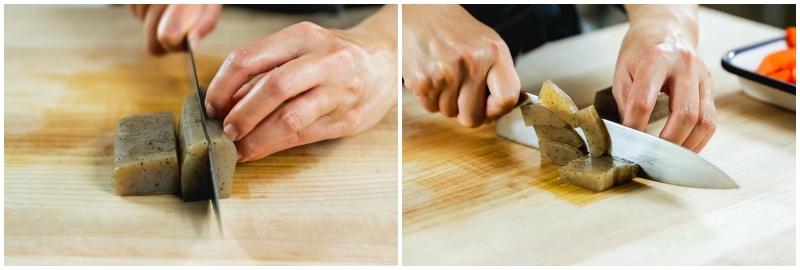
- Sprinkle ¼ tsp Diamond Crystal kosher salt on the konnyaku and rub it well with your hands. Let it stand for 5 minutes. Tip: The salt releases moisture along with the unwanted odor from the konnyaku.
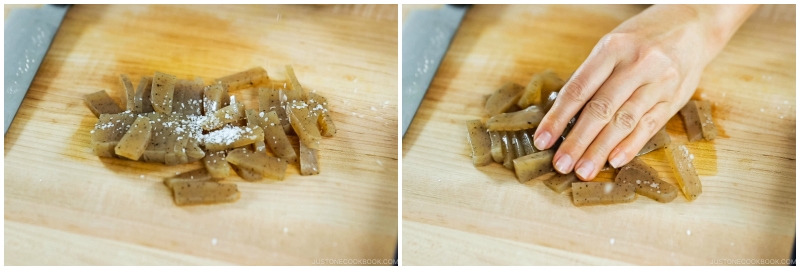
- In the meantime, bring a small saucepan of water to a boil. Once boiling, add the konnyaku.
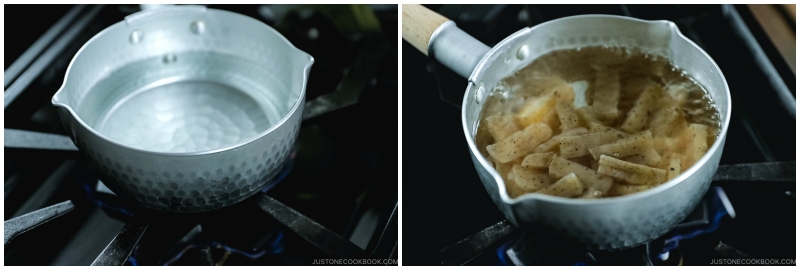
- Cook the konnyaku for 2–3 minutes, drain the water, and set aside. Tip: This helps to remove the unwanted odor.
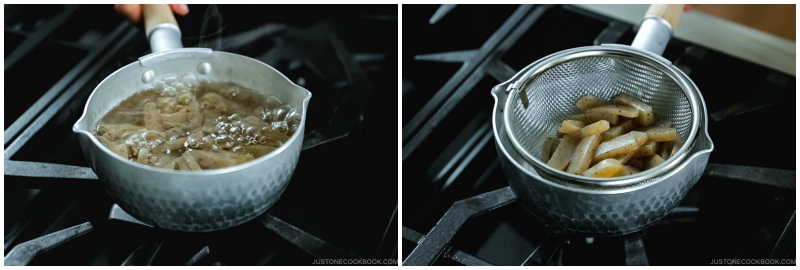
- Slice 1 Tokyo negi (naga negi; long green onion) diagonally.
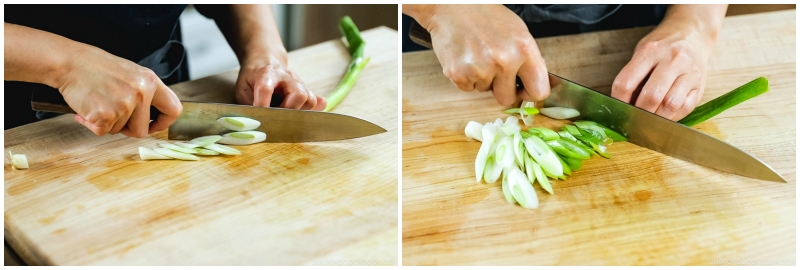
- Remove the excess oil from 1 piece aburaage (deep-fried tofu pouch) with a piece of paper towel.
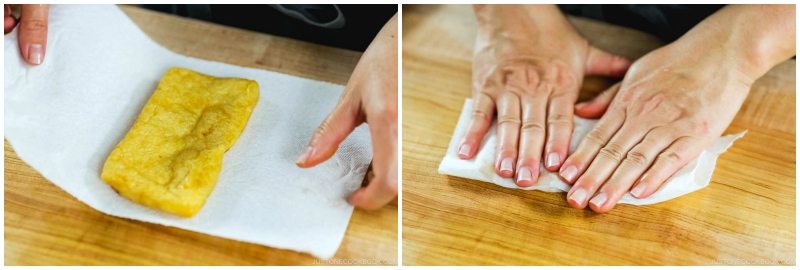
- Cut the aburaage in half lengthwise and thinly slice it.
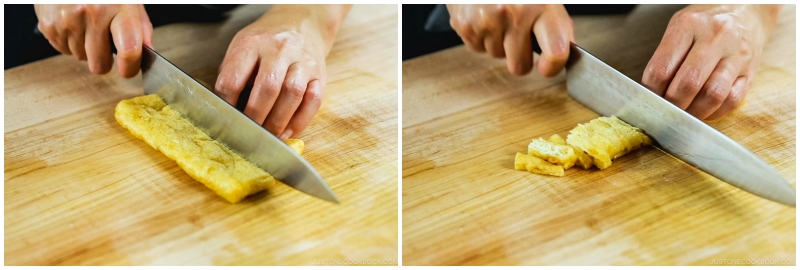
- Peel and grate the ginger (I use a ceramic grater) and measure 1 tsp ginger (grated, with juice).
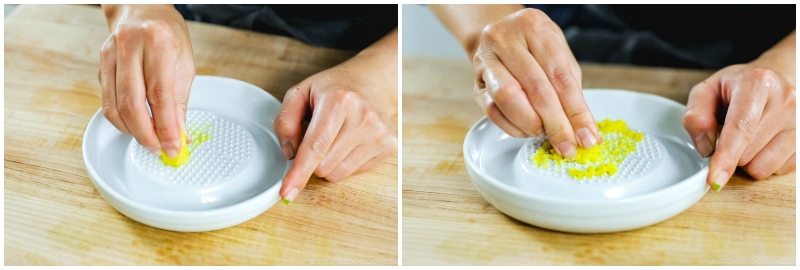
- Cut 1 green onion/scallion into thin small rounds to use as garnish on top of the miso soup. Keep them in a bowl and set aside.
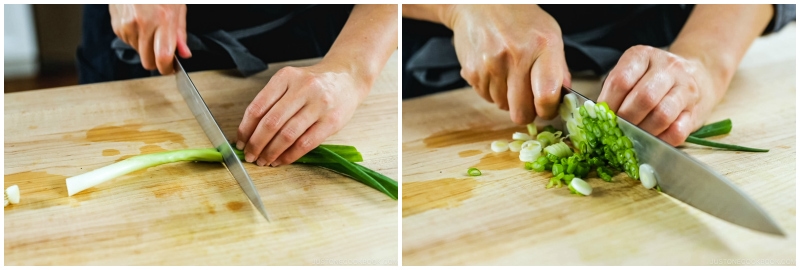
To Cook the Tonjiru
- Preheat a large pot (I use a Le Creuset Dutch oven) over medium heat. When hot, add 1 Tbsp toasted sesame oil.
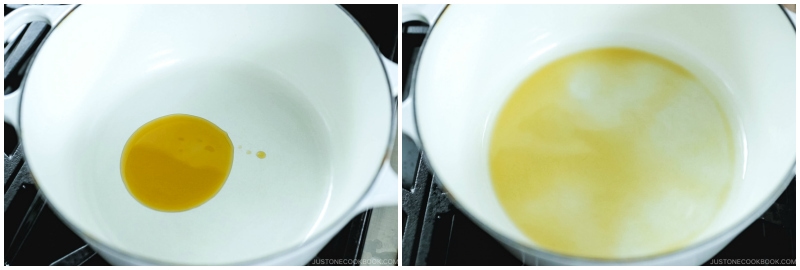
- Add the pork belly and stir-fry with a spatula.
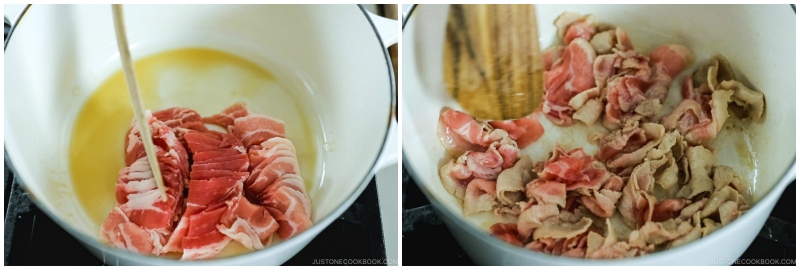
- When the pork is no longer pink, add the onion.
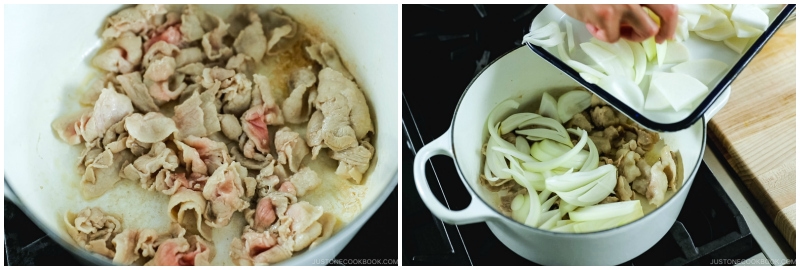
- Stir-fry the onions. Then, add the daikon and carrot slices.
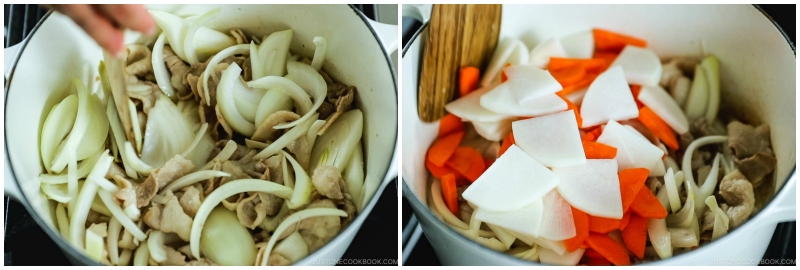
- When the ingredients are coated with oil, add the gobo and taro.
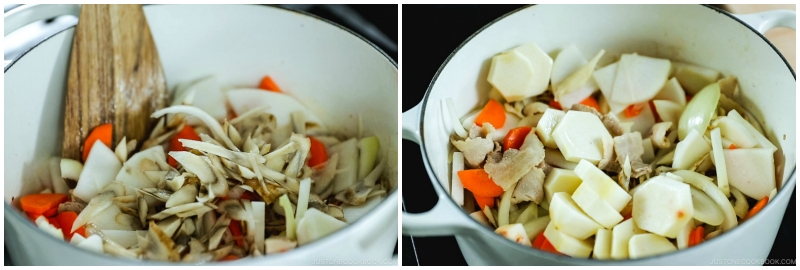
- Add the konnyaku, aburaage, negi, and 6 cups dashi (Japanese soup stock). There should be just enough dashi to cover the ingredients. If not, add more dashi or water.
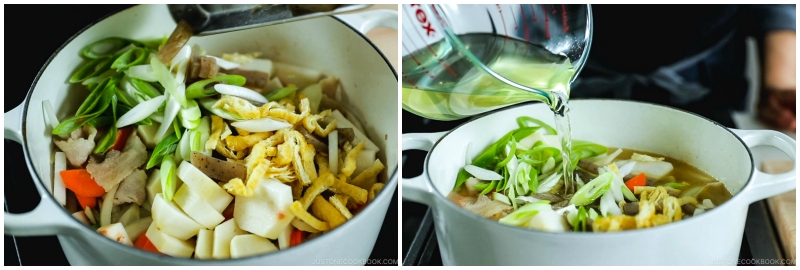
- Stir to mix, cover with a lid, and bring it to boil.
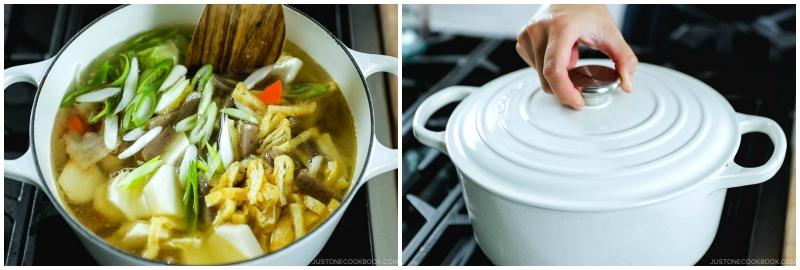
- When boiling, lower the heat and skim off the scum and fat from the soup.
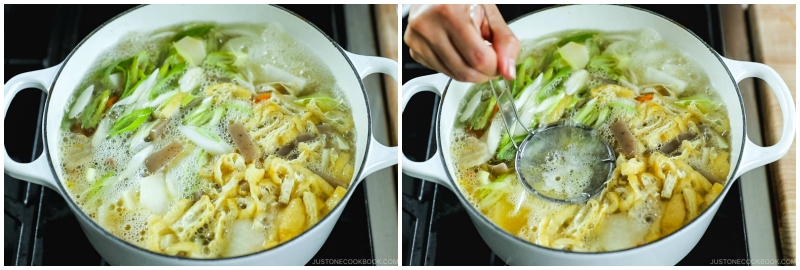
- Simmer, covered with the lid, until the root vegetables are tender, about 10–15 minutes.
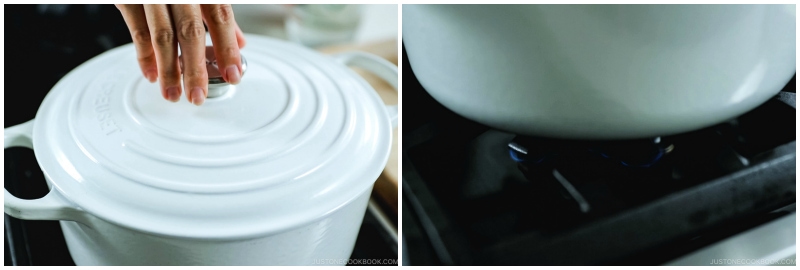
- The Tonjiru is done cooking when a skewer inserted into a tough and thick vegetable pierces through. Turn off the heat. If you are preparing this dish ahead, stop here and let it cool completely before storing the pot in the refrigerator.
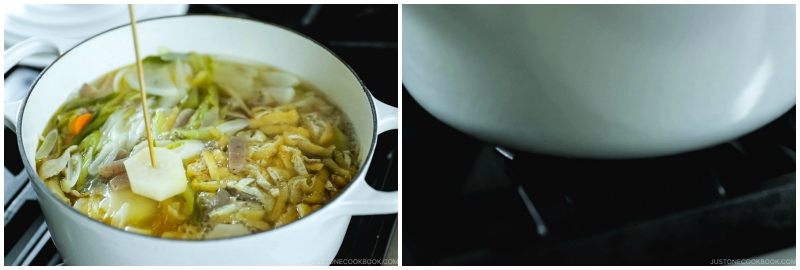
To Serve
- For the best flavor and aroma, add the miso right before serving, if possible. Dissolve 6 Tbsp miso into the soup using a strainer. (Tip: Always start adding a little less than the recipe calls for; each brand/type of miso has different saltiness.) If you don’t have a strainer, let the miso completely dissolve in the ladle first before releasing it to the soup. Taste the soup. If it's too salty, add dashi or water to dilute.
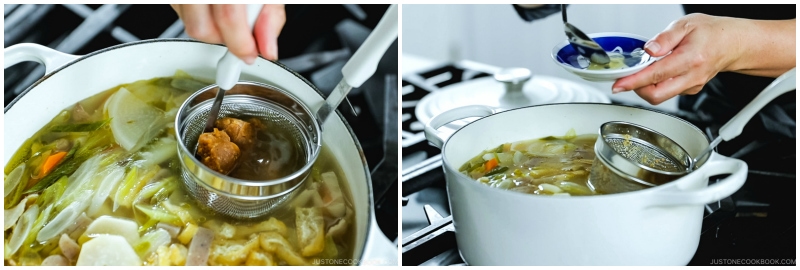
- If the soup needs more seasoning, add more miso (I added 1 Tbsp). When you are done adding the miso, add the grated ginger. Tip: When you add the tofu (always add tofu after the miso as it is delicate), make sure your miso soup has a slightly stronger taste because the moisture from the tofu will dilute the flavor.
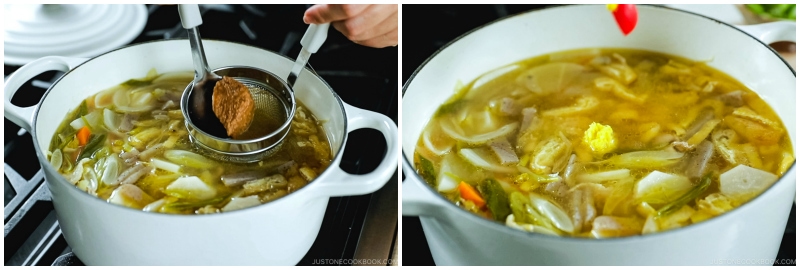
- Tear 7 oz medium-firm tofu (momen dofu) into small pieces and add them to the soup. Alternatively, you can cut the tofu into cubes instead of tearing it. Tip: Tearing adds more surface area to the tofu and will help it absorb more miso flavor from the soup.
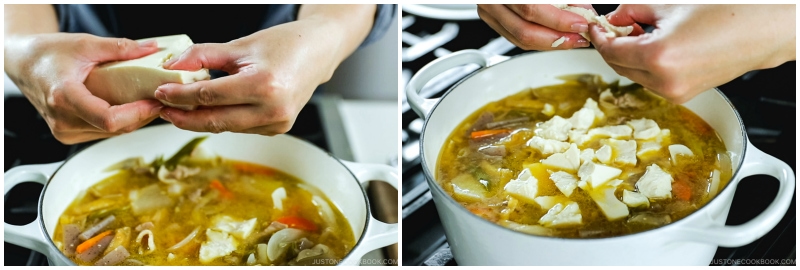
- When you are ready to serve, reheat the Tonjiru on medium-low heat and keep it at a low simmer. NEVER let the miso soup boil because miso will lose its flavor.
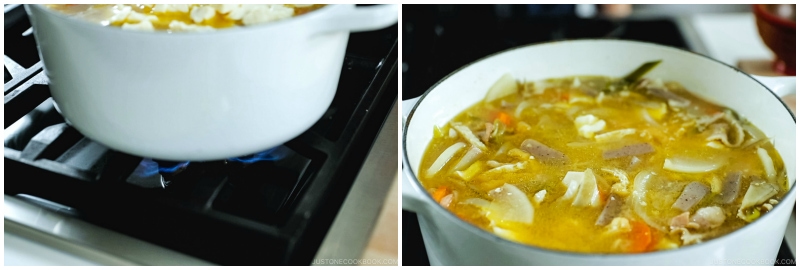
- Serve the Tonjiru in miso soup bowls, sprinkle with green onion, and serve immediately. Sprinkle in some shichimi togarashi (Japanese seven spice) at the table for an optional spicy kick.
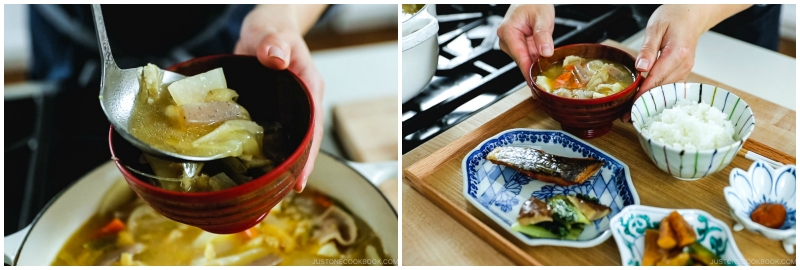
To Store
- Let the Tonjiru cool completely before storing it in the refrigerator. Consume within 5 days.
Nutrition
Editor’s Note: The post was originally published in 2011. The post has been republished with new images and content on July 8, 2020.
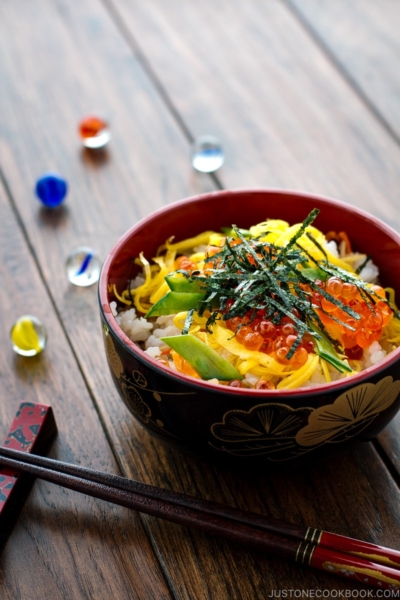

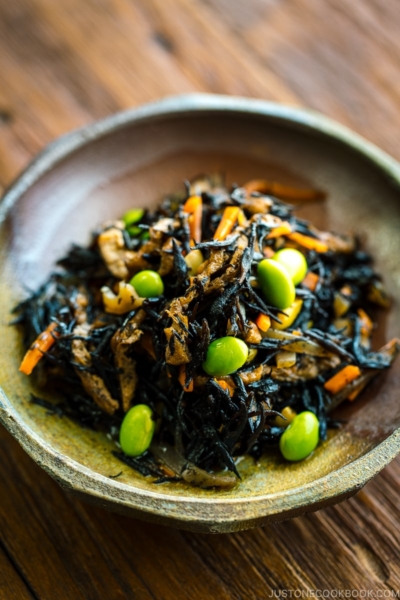
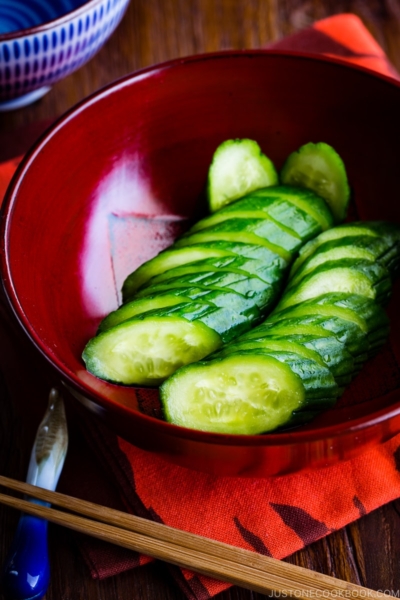
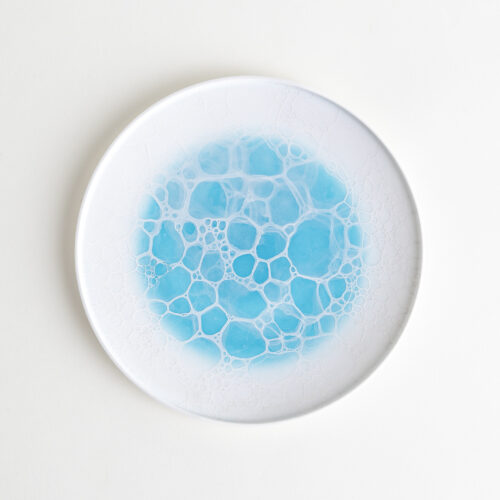
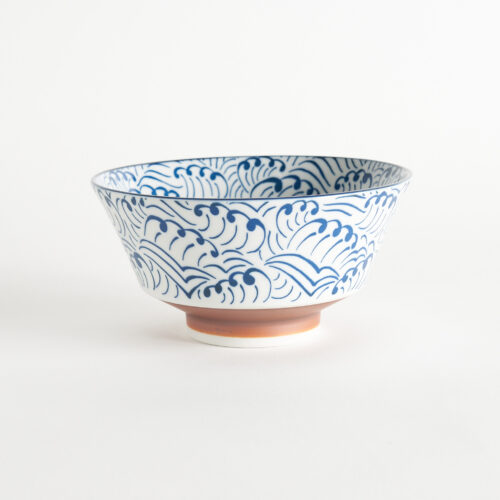
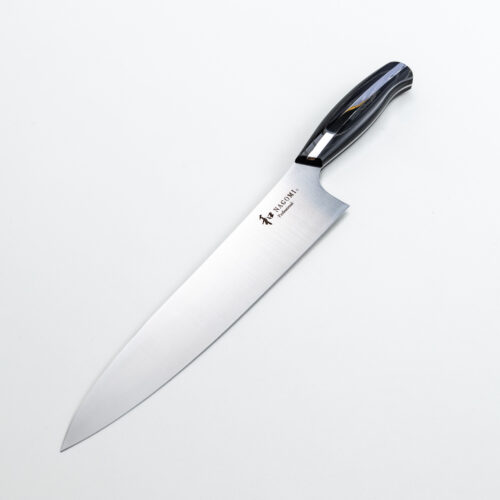
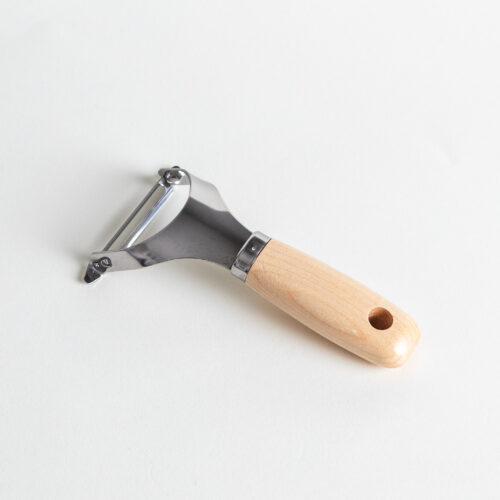
So delicious! We bought two large daikons and I had no idea what to do with them so I made this recipe. I didn’t add the tofu (because we didn’t have them on hand) and the recipe still turned out delish! Very hearty and healthy, a new favorite way for us to sneak in veggies!
Hi, Thy! Thank you for trying Nami’s recipe.
We’re glad to hear you enjoyed this dish. Thank you for the kind words and sharing your experience with us!
Hello Nami
Would this receipt still work if I replace the pork with chicken wings or diced thigh?
Thank you
Hi, Ton! Thank you for trying Nami’s recipe.
If you use chicken, the dish’s name will change, but you can still use chicken wings or diced thighs. We hope you enjoy it!
Dear Nami, I just wanna thank you so much for this recipe. I’ve been following you for a couple of years now and I’m glad I discover your Tonjiru recipe last year, and I’ve been cooking this dish almost every week.😋 This is such great comfort food, especially on cold rainy nights. My hubby and I both love this soup so so much. Thank you once again! 🤗
Hello Kim! Your Tonjiru photo looks wonderful!
We’re so happy to hear that you’ve added this soup to your weekly meals. Thank you for trying Nami’s recipe and for your generous feedback. We really appreciate your love and support. Happy cooking! 🤗
Another family favorite! We absolutely love your recipes! We had your Tonjiro tonight as part of our anniversary dinner. We fell in love with it when I first came across it a few years ago. I was so excited this time to make it because I grew gobo this year in my garden and was able to use it. Absolutely delicious! Thank you so much for all you do!
Hello, Brandy! Aww. Thank you very much for your thoughtful feedback! And congratulations on your anniversary!
Homegrown gobo must be tasty! Thank you for experimenting with Nami’s recipe.
Here are some more Gobo recipes for you to try! We hope you enjoy these recipes as much as we do.
https://www.justonecookbook.com/#search/q=gobo
I made this with only onions and carrots for veggies because we had picked up some sliced pork belly from Mitsuwa and had miso as well. I was worried it wouldn’t be that good because we were missing most of the ingredients, but it was amazing!! I even used just water instead of dashi. Going to make it again with more of the other veggies.
Hi Heidi! Thank you so much for reading Nami’s post and trying her recipe!
We are glad to hear you enjoyed the soup. 😊
Happy Cooking!
We love this soup. I’ve made it a few times and it’s a family favorite. Yum!!!
Hi Beau! Thank you very much for trying Nami’s recipe and sharing your Tonjiru photo with us! It looks so good.
We are glad to hear everyone enjoyed the homemade Tonjiru. Happy Cooking!💞
Hi! I love so much this recipe and I relax so much cooking Japanese! I’ve done it for the JOC March challenge.
Thank you for your website, it is an inspiration and I always learn so much!
Hi Ilaria! Aww. Nami and all of us at JOC are so happy to hear you enjoy cooking Japanese food and Nami’s recipes.❤️
Thank you so much for sharing your photo of Tonjiru. It looks so delicious!
Fantastic recipe. My husband and I make it about every other week! We usually do without the burdock, as I find it somewhat troublesome to prep, and it still turns out wonderfully.
Hi Jill! Thank you very much for trying Nami’s recipe and for your kind feedback!
We are so glad to hear you and your husband enjoy it very much. 🤗
If you can access burdock, please give it a try! It will add an earthy flavor to the soup.
Happy Cooking!
My daughter and I both got really bad colds so we decided to try this recipe. Unfortunately I couldn’t find half the vegetables for this recipe but I substituted them with some local harvest vegetables. It was so tasty and I felt so good eating it! Will definitely make this again!
Hi Amanda! We hope you and your daughter are feeling better now.🙂
Thank you very much for trying Nami’s recipe and sharing your cooking experience with us.